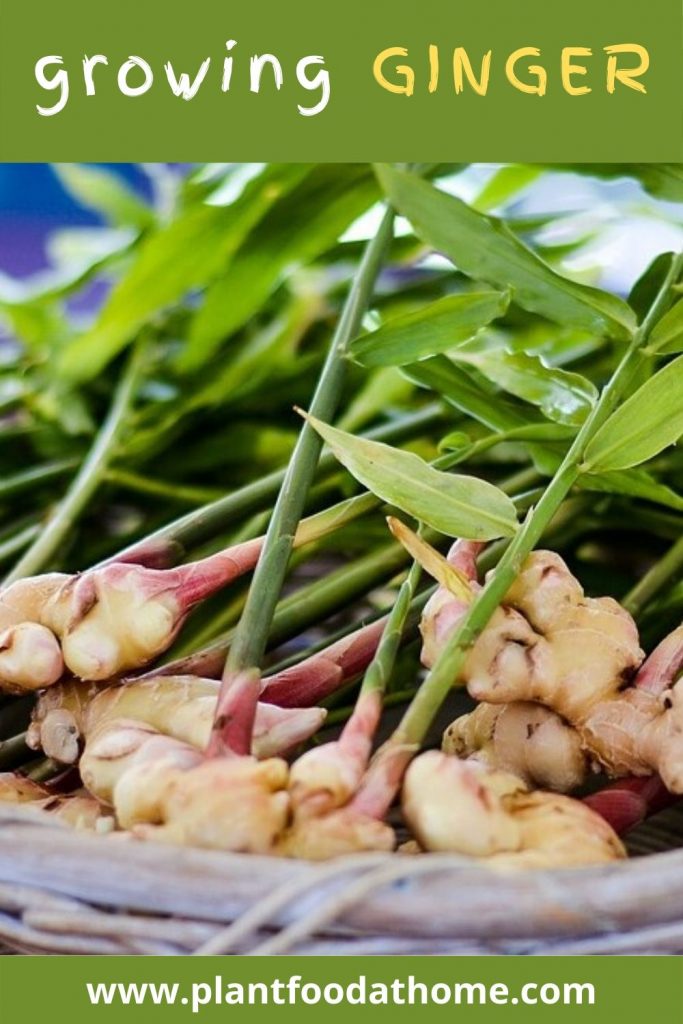Ginger is an aromatic, spicy and delicious plant you can grow in your edible garden at home. And by growing your own ginger, you can control the chemicals and pesticides used. I love growing ginger organically, and you can too. Learn how to grow ginger in our guide to growing ginger at home.
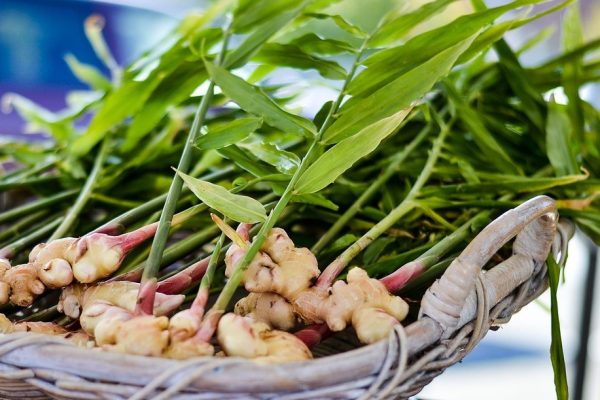
Related: Why Is My Ginger Plant Dying? | Galangal Vs. Ginger: What’s the Difference?
Table of Contents
What Is Ginger?
Firstly, there are numerous varieties of ginger plants that are both edible and ornamental. While even ornamental gingers have edible parts, it is common ginger which is most often grown for eating. Common ginger is also known as culinary ginger.
A widely used spice, ginger (botanical name Zingiber officinale) comes from the Zingiberaceae family which also includes turmeric, cardamom, and galangal.
Ginger originates in Southeast Asia and now grows around the world.
Ginger is a tropical, herbaceous perennial, and flowering plant, with horizontally grown rhizomes producing shoots and roots. The ginger rhizomes are thick and coarse with yellowish-brown outer skin.
The green shoots or leaf stems are leaf sheaths that wrap around each other. The long and narrow leaves are the same color as the leaf stems and grow in an alternate pattern.
Roots sprout from the rhizomes growing up to 2-6 inches (5-15 cm) in length and spreading outward.
If grown undisturbed for 1-2 years, flowers will bloom from a leaf stem through a mature rhizome. The flower’s color varies from yellow-green to light yellow with purple tips. Ginger flowers are edible too.
The plant generally grows up to 36-48 inches (90-120 cm) tall.
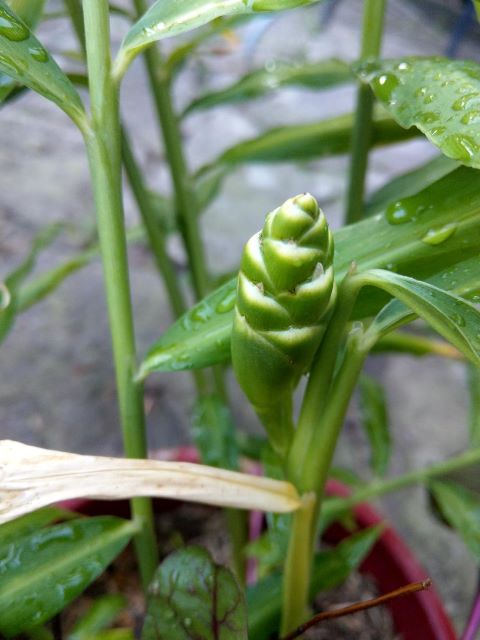
Is Ginger A Root?
Sometimes mistakenly called ginger root, ginger is, in fact, a rhizome.
Calling it ginger root would seem logical, given the edible part of the ginger plant grows underground.
The rhizomes produce shoots that grow above ground and roots grow out from the rhizome.
How To Grow Ginger
The easiest way to propagate ginger is by getting fresh rhizomes from an existing plant that has growth buds or nodes on them.
You can also plant grocery-store ginger rhizomes. More on this later.
Climate
Ginger thrives best in subtropical and tropical climates where it is warm and humid.
The ideal temperature for a ginger plant is about 77°F (25°C) and should not be below 55°F (12°C) in the colder months. If the temperature gets too cold, the foliage will die back and rhizomes will wither and fail.
As a perennial plant, ginger will regrow in warm climates after it dies back during fall.
Ginger grown in cold climates can be overwintered for replanting in spring.
Soil
Healthy soil is important for growing healthy ginger plants. The ideal soil has a pH ranging from 5 to 6.5. Ginger prefers soil that is rich, loamy and sandy/loose which retains moisture but also provides good drainage so it doesn’t get soggy.
Amending soil with good-quality compost and well-rotted manure before planting helps improve the soil quality and provides the ideal conditions for growing ginger root.
Sun
As a tropical plant, ginger thrives with plenty of sunlight, though during very hot weather, ginger will benefit from some protection from harsh midday and afternoon sun.
In a cooler climate, ginger grows best in full sun, with 6-8 hours of sunlight a day.
Ginger will also grow in partial shade.
Water
After initially planting your ginger rhizome, water once to start the growing process and then water only sparingly, if at all, until you can see the beginning of the ginger shoots. In very dry conditions, occasional light watering can be provided if there is no natural rainfall.
Withholding water at this point helps to prevent the ginger rhizomes from rotting in the soil before it has a chance to shoot. When new shoots start sprouting through the soil, frequent watering can begin.
Established ginger plants thrive with plenty of water on a regular basis. Frequent watering is important to produce healthy and plump ginger rhizomes. I have drip irrigation to my ginger to provide regular watering.
Test moisture in the soil with a water gauge or by using your finger by pushing it into the soil near the plant up to your second knuckle. If the soil is moist there is no need for additional water but if it’s dry, give the ginger a drink of water.
It is important the soil is free draining so water doesn’t cause the soil to become soggy and cause the ginger to rot.
Using an organic mulch around the ginger plant will help retain soil moisture and protect the plant from drying out.
Fertilizer Recommendation For Ginger
Like many plants, ginger thrives with healthy soil, rich in nutrients. Prior to planting the ginger rhizomes, amend the soil with compost and well-rotted manure.
Ginger growth can be supported with a well-balanced organic fertilizer. Use as directed.
Or feed with chicken pellet manure and a top dressing with compost once or twice in the growing season.
A liquid seaweed fertilizer every 2-6 weeks can also support ginger growth.
By also using an organic mulch around the ginger plant, not only will you be protecting the soil from drying out but you will also be providing additional food for the plant as the mulch breaks down over time.
How To Plant Ginger
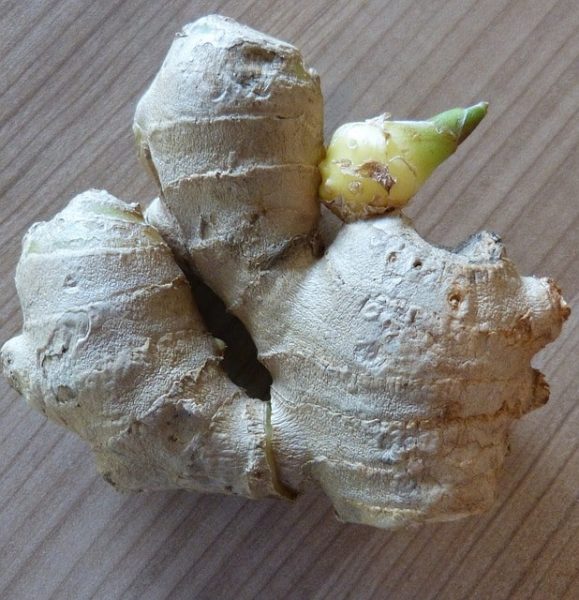
Ginger can be planted in the ground or grown in a pot.
In warm tropical climates, ginger does very well grown directly in the garden.
For cooler climates, it’s best to grow ginger in a pot or container so it can easily be moved indoors or sheltered when the cooler weather sets in.
Ginger rhizomes can be divided into 2-3-inch (5-7.5 cm) long pieces. Either break them up gently at a spot where the rhizome is naturally narrow or use a clean sharp knife to divide them. Ideally, look for 2 or 3 growth buds, though this is not essential.
It’s good practice to allow the wounds to heal where the rhizome has been cut and the surface develops a callus. This helps prevent the ginger from rotting when it is planted. This process can take a couple of days.
Once the cuts cure, it’s time to plant.
Tip: Don’t be tempted into dividing ginger rhizomes into really small pieces in the hope of producing more plants. Keeping them at 2-3 inch (5-7.5cm ) pieces will give the ginger rhizome a better chance of establishing in the soil and then producing a great harvest.
Growing Ginger In The Ground
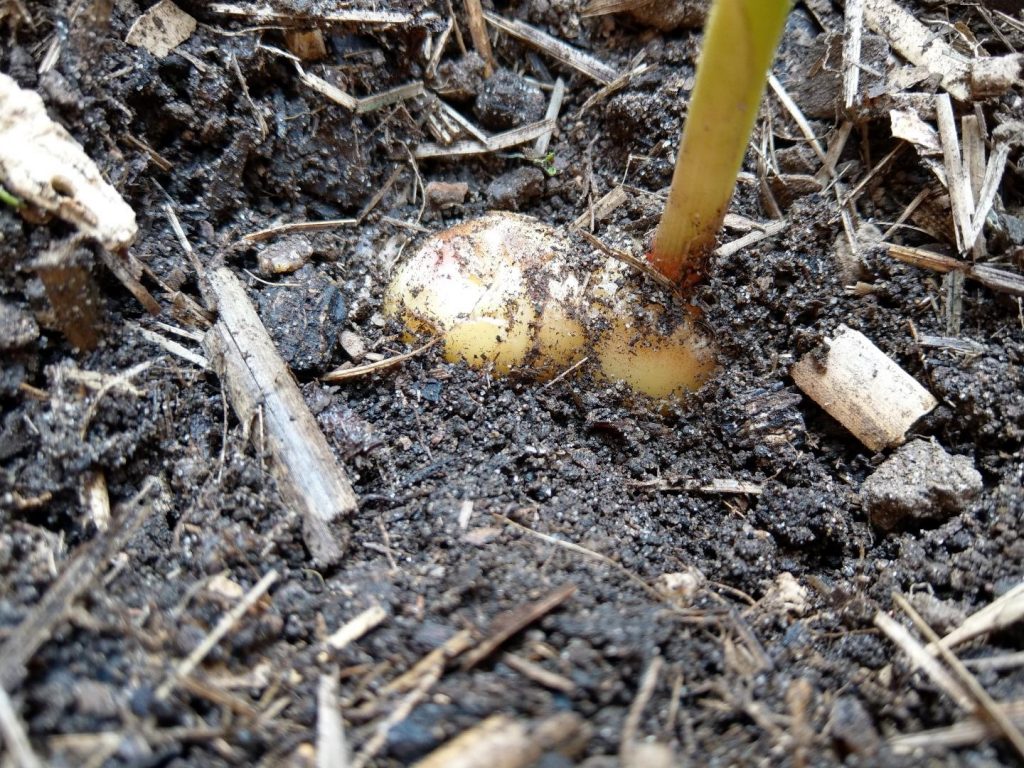
- Prepare the soil with compost and well-rotted manure. The addition of an all-purpose organic vegetable fertilizer or chicken pellet manure can also be added at this time.
- Space the rhizomes approximately 6-8 inches (15-20 cm) apart.
- Ginger rhizomes do not need to be planted very deeply, about 1 inch deep is ideal. If you can spot them, plant the rhizomes with the growth buds facing up.
- Cover the rhizomes with soil and gently pat the soil down.
- If the soil is already moist, watering is not required until new shoots emerge. If the soil is dry to begin, water once to help bring the ginger rhizome out of dormancy. Then hold off watering until you see shoots sprouting.
- In 2-3 weeks the ginger will start sprouting though it could be as long as 6 weeks.
Growing Ginger In A Pot
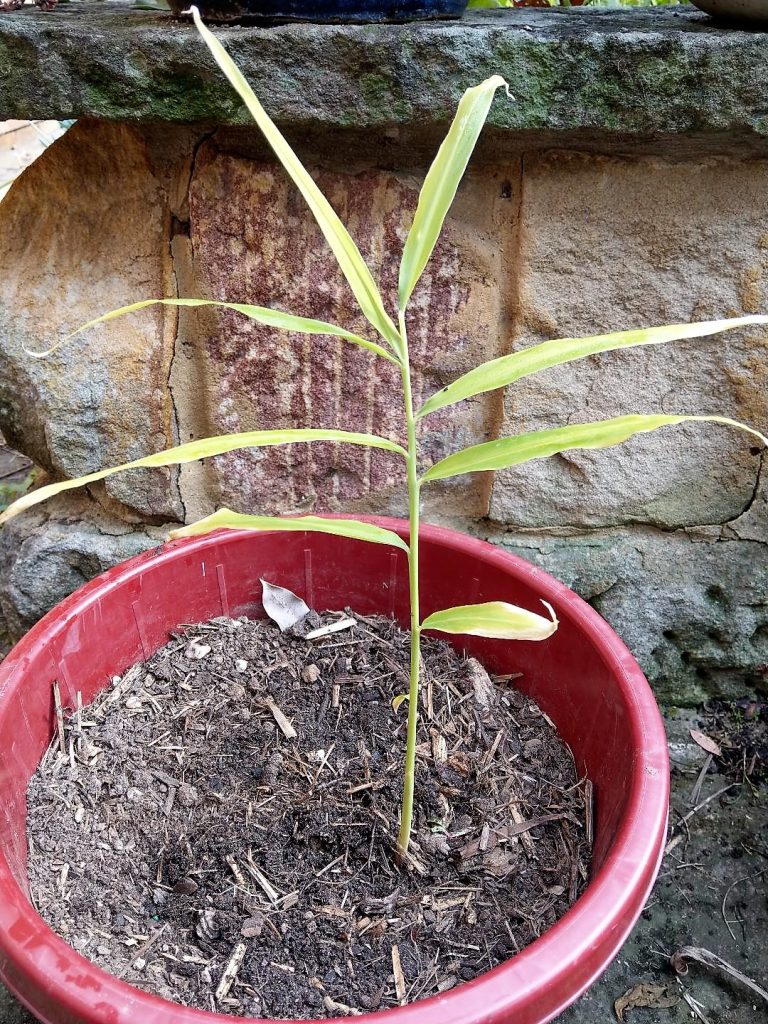
- Choose a pot size at least 12-16 inches (30-40cm) in diameter to give your ginger plant enough room to grow. As ginger grows horizontally, and rhizomes grow close to the soil surface, having a deep pot is not necessary, though they can grow at least 6 inches (15cm) down so ensure you have an adequate pot size.
- Fill the pot with a good quality potting mix. Add in some compost and well-rotted manure or an all-purpose organic vegetable fertilizer or chicken pellet manure.
- Plant about 3 rhizomes for a 14-inch (35 cm) pot.
- Plant the ginger rhizomes about 1 inch deep with the growth buds facing up and gently firm down the soil.
- If the soil is already moist, no watering is required until shoots start growing. If the soil is dry then water once to help bring the ginger rhizome out of dormancy and then water only when you see shoots begin sprouting.
- The ginger should start to sprout in about 2-3 weeks but could take up to 6 weeks.
When To Plant Ginger
The best time to plant ginger is in spring when all chance of frost has passed.
In cooler climates, ginger can be started indoors to get a head start on the growing season. And then when the weather warms up, ginger can be moved outside in a pot or planted out in the garden.
How To Regrow Ginger
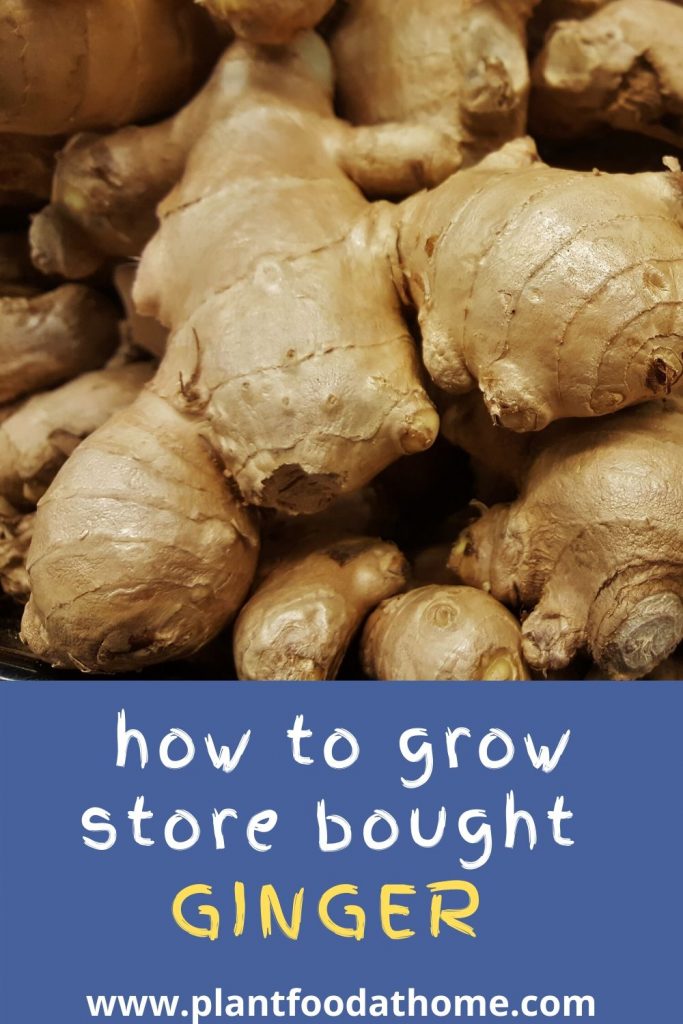
Have you ever wondered, can you plant ginger root from the grocery store? Well, the answer is yes, you can plant shop-bought ginger.
It’s a good idea to purchase organic ginger for planting. This is because commercially grown ginger rhizomes are often treated with a growth retardant or sprouting inhibitor.
If you are unsure whether your ginger has been treated with a chemical retardant, you can soak the ginger rhizome in water for a couple of hours or even overnight. Washing them will help to remove the retardant for your best chance of successfully growing ginger.
Select ginger rhizomes with well-developed growth buds or nodes on them if possible, though this isn’t essential. Look for healthy, plump ginger that has not shriveled with age.
How Long Does Ginger Take To Grow
Growing ginger takes 8-10 months to fully mature. However, you can start harvesting a small piece of rhizome any time after 4-6 months.
Once the weather turns cold, plant stems will start to wither and die back. This usually coincides with when to harvest ginger.
For ginger grown in pots, the rhizomes can overwinter in the pot provided it is moved into a dry protected position. Withhold water at this time or the ginger rhizomes may perish in cold wet soil.
If you live in a cold climate and growth has not been strong, it can be a good idea to overwinter the ginger as described above so that it can grow for a second season, before harvesting.
Another option is to store ginger rhizomes for planting until the following growing season in dry sand.
The rhizome should remain completely dry to preserve it until the following season when it can be replanted in the ground or a pot in spring.
How To Harvest Ginger
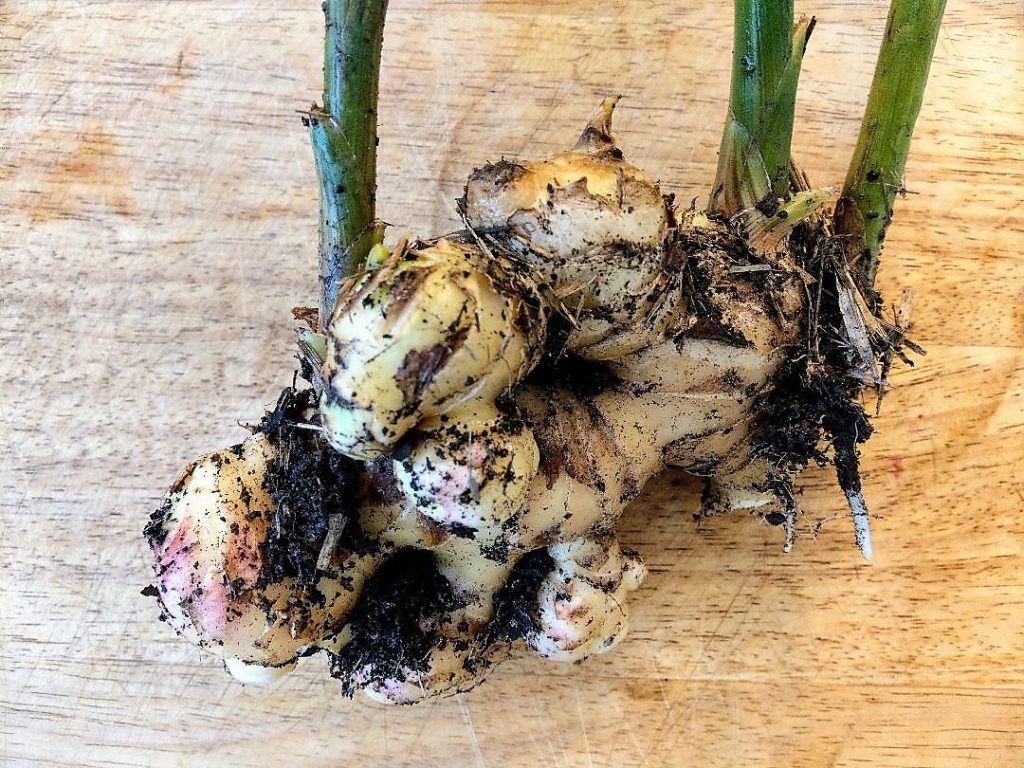
You can start harvesting a few bits of rhizomes after 4-6 months by carefully digging the sides of the ginger rhizome clump.
Make sure to leave the other rhizomes with leaves so it can continue to grow.
When it reaches 8-10 months and the rhizomes are fully mature, you can harvest the full crop of ginger.
Loosen the soil around the plant and gently lift the plant.
Select rhizomes with good growing buds or nodes to be kept for the next planting season. Keep the rest for culinary and other kitchen purposes.
If you’re looking for ways to use ginger, have a look at our Tomato Chili And Ginger Jam Recipe and this Cherry Ginger Smoothie with Greek Yogurt recipe.
How To Store Ginger
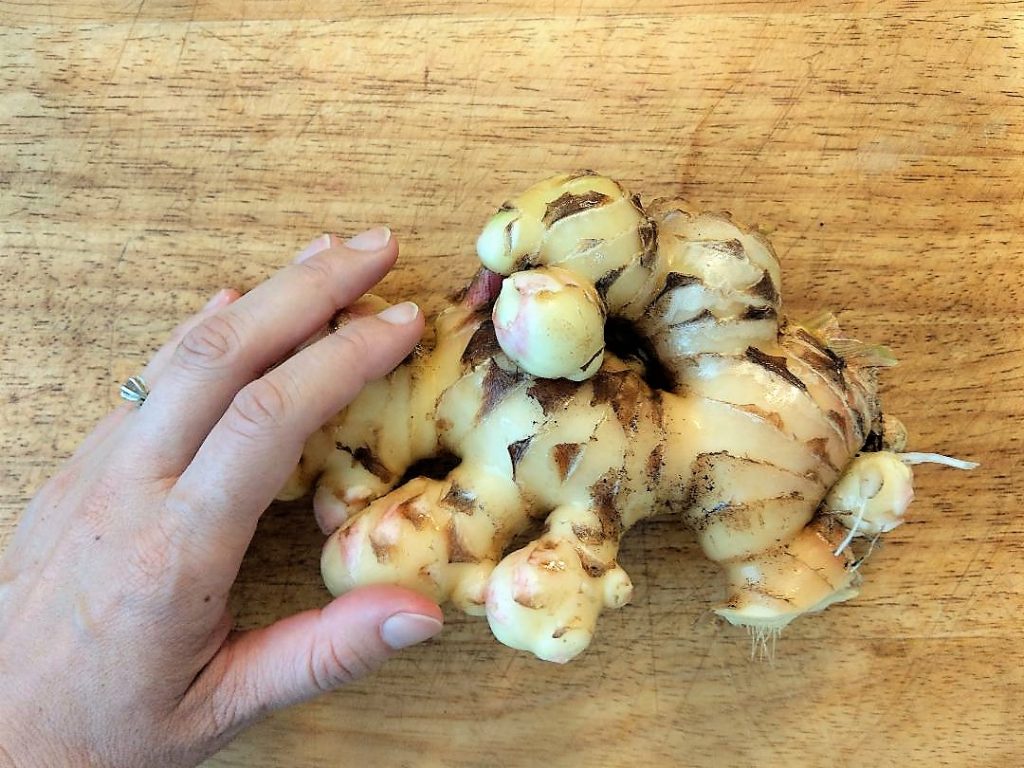
Ginger can be stored in several ways, here are some ideas:
Storing Fresh and Unpeeled Ginger
Left on the countertop, fresh ginger will keep for about a week. Placed in a resealable plastic bag and stored in the fridge, ginger can last 3-4 weeks.
Storing Peeled And Sliced Ginger
Wrapped in a paper towel, placed inside a plastic bag and stored in the fridge, peeled and sliced ginger can last up to 4 weeks.
How To Freeze Ginger
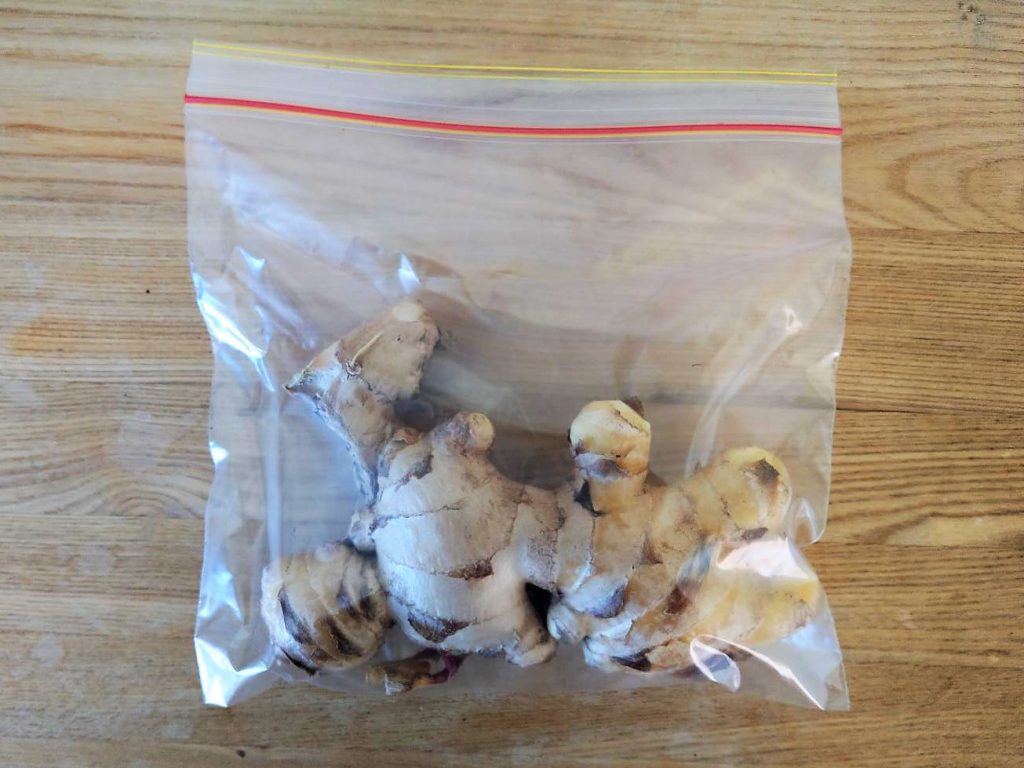
Freeze ginger by placing the ginger whole and unpeeled into a freezer bag. To use the ginger, simply peel the piece of ginger you intend to use (thawing not necessary), grate the required amount and then replace the rhizome in the freezer.
Another option is to peel the fresh ginger, grate it and place it in ice cube trays to freeze. Then once frozen, store ginger ice cubes in freezer bags and use as needed.
A third option is to puree peeled ginger in a food processor with a small amount of water. Fill ice cubes trays with pureed ginger, freeze and then store the frozen ginger ice cubes in freezer bags and use as required.
Frozen ginger can last around 6 months.
Pickled Ginger
Pickled ginger stored in a glass jar and refrigerated can last up to 6 months.
Dried Ground Ginger
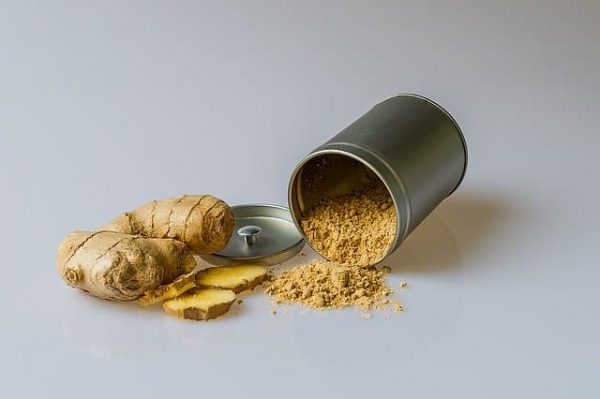
Dried ground ginger has a long shelf life.
To dry ginger easily, use a food dehydrator or in the oven set to a low temperature.
Store dried ground ginger in an airtight container and place it in a cool, dark cupboard away from heat and sunlight. If properly stored, it can last up to 3-4 years.
Pests and Disease
Like many other herbs in the garden, ginger is also susceptible to pests and diseases. Here are some to look out for.
Root Knot Nematodes: They can cause damage to the ginger rhizomes preventing them from establishing properly.
To control these pests, add good, beneficial nematodes to the soil to get rid of the bad ones. This can be achieved by purchasing beneficial nematodes here or in a garden center or by providing healthy homemade compost to the soil which will provide beneficial nematodes.
Horticultural neem oil can also be used for control of the bad nematodes without harm to the beneficial nematodes.
Mealybugs: Other pests are mealybugs; they live on the stems and under the leaves of the plants.
You can use a cotton swab dipped in alcohol to remove them. They can also be removed by mixing water, dish soap, and horticultural neem oil in a spray bottle and spraying the plant until it is soaked with the treatment.
Neem oil is also the preferred treatment for Aphids, Red Spider Mites, Thrips, Fungus Gnats, and Chinese Rose Beetles. These pests feed on the leaves and neem oil reduces the appeal of the leaves.
The most common diseases of the ginger plant are Bacterial Wilt and Root Rot.
Bacterial Wilt causes damage to the leaves and stems.
The easiest way to treat these is to remove the damaged leaves and stems and by inspecting the plant for any signs to prevent it from spreading.
An organic bactericide can be applied to treat them.
It would also be useful to practice crop rotation by rotating ginger with crops less susceptible and not hosts to bacterial wilt like sweet potato.
Root Rot is very common in soils that are too wet. To prevent this, make sure that the soil is well-draining.
Conclusion
Growing ginger is easy when you start with well-prepared healthy soil. After planting ginger rhizomes, remember to give the plant adequate water once the ginger rhizomes begin to sprout to ensure a bountiful harvest. Then enjoy the satisfaction of harvesting your own homegrown ginger and using it to spice up your dishes.
Recommended Products
- Soil, Light and Water Gauge
- Organic All-Purpose Vegetable Fertilizer
- Chicken Pellet Manure
- Liquid Seaweed Fertilizer
- Organic Potting Mix
- Food Dehydrator
- Horticultural Neem Oil
Related reading:
- How to Grow Turmeric and Make Your Own Turmeric Powder
- How to Grow Lemongrass: Planting and Growing Guide
- Drought Hardy Herbs To Plant At Home
- Growing Bulb Onions: 20 Things You Should Know
- How to Grow Garlic: Growing and Harvesting the Best Garlic
- Curry Leaf Plant: Growing, Caring and Eating Curry Leaves
- Globe Artichoke Vs. Jerusalem Artichoke: What’s the Difference?
- Horseradish Dying? Common Causes and Solutions
- Perennial Vegetables to Plant Once and Harvest Forever
